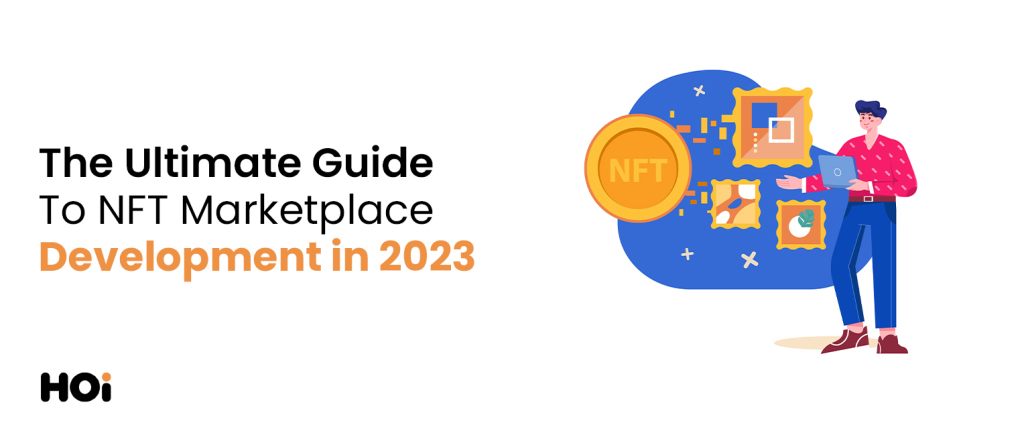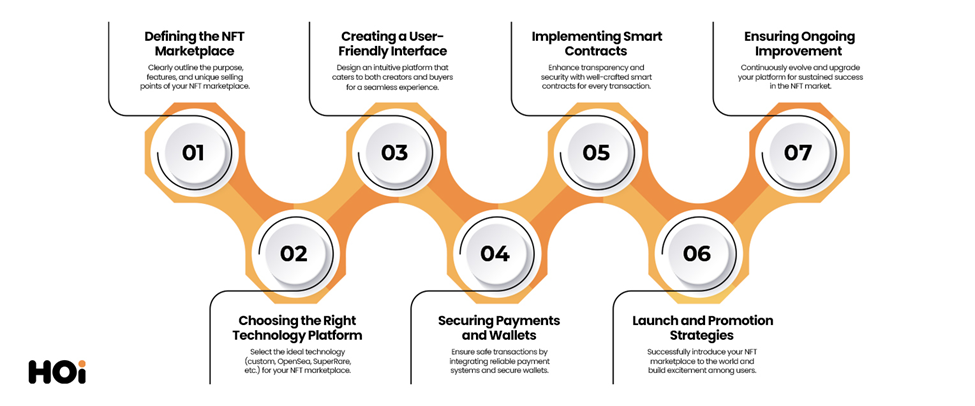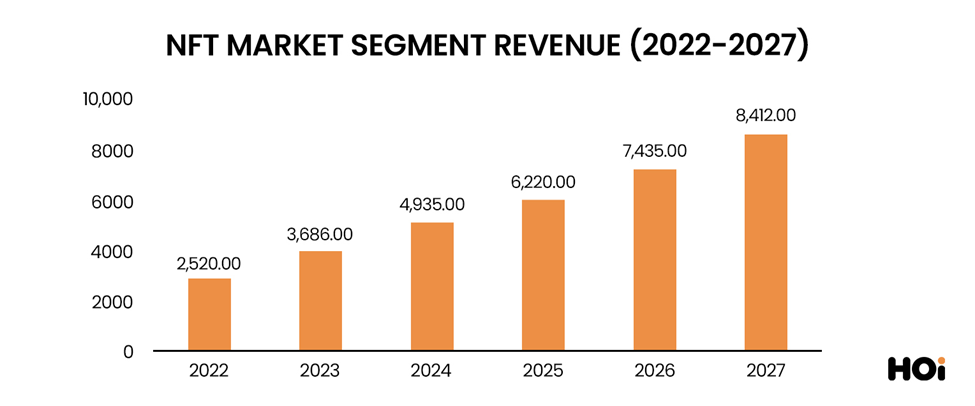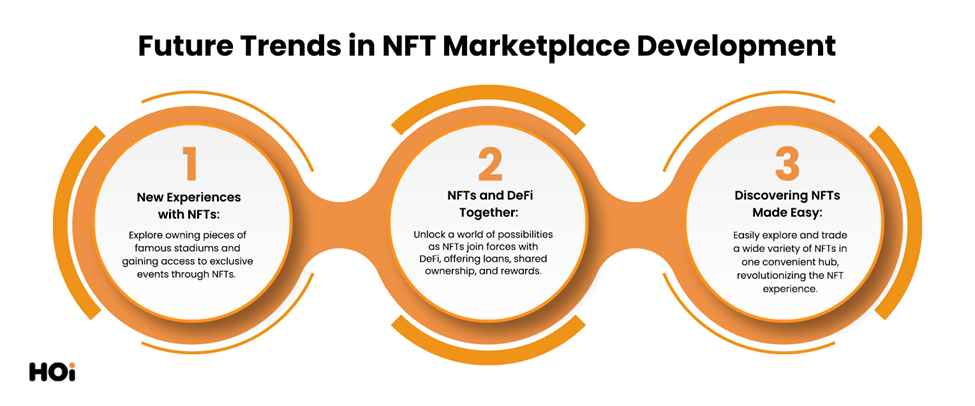The Ultimate Guide To NFT Marketplace Development In 2023

The rise of NFTs has taken the digital world by storm, introducing a revolutionary model for acquiring, selling, and trading digital assets. Whether it’s exclusive digital artworks, music compositions, collectible sports cards, or even virtual real estate, NFTs provide a platform to own a unique piece of digital content that is authentic and immune to duplication.
However, the question arises: where does one navigate to engage in the buying and selling of these rare digital treasures? Enter NFT marketplaces, the virtual arenas that facilitate the exhibition and transaction of NFTs. These online platforms serve as the focal point where creators showcase their unique digital creations, while buyers can securely acquire these distinct digital assets.
Now, what is NFT marketplace development, and what makes this market a prime growth opportunity for businesses? These are some questions we are looking to answer for you. This blog post is your guide, providing every necessary piece of information you need to develop an NFT marketplace.
What Are NFTs?
NFTs, or non-fungible tokens, are digital tokens on a blockchain. They represent one-of-a-kind assets like art or digital content, providing incontrovertible proof of ownership and authenticity for any digital items.
Unlike cryptocurrencies like Bitcoin or Ethereum, which are interchangeable with each other, NFTs are distinct and cannot be exchanged on a one-to-one basis due to their attributes.
NFT marketplace development serves as an intermediary between creators and collectors. They provide a platform for creators to mint (create) NFTs, list them for sale, and for buyers to discover, bid on, or purchase them. This NFT marketplace architecture also facilitates secure transactions providing a space for community interaction among collectors and creators.
Start your NFT marketplace development with us, where every digital creation finds its perfect home.
How Do NFT Marketplaces Operate?
Artists showcase their work on 3D and 2D NFT marketplaces, where buyers can bid or purchase directly. While some art goes for millions, there are affordable options too. If animated art is your thing, you’ll discover cheap NFT GIFs.
Let’s walk you through the complicated process followed by NFT creators and answer your question about how to develop an NFT marketplace.
Step-By-Step Guide To NFT Marketplace Development
NFT marketplaces provide a platform for creators to mint, and sell their digital assets. So, If you want to develop an NFT marketplace, this step-by-step guide will help you navigate the process.

1. Defining The Purpose And Features Of The NFT Marketplace
Before you begin to develop an NFT marketplace, you need to clearly define the purpose of developing your NFT marketplace. Consider questions like:
- What type of NFTs will be featured (art, music, virtual real estate, collectibles)
- Will there be any specific niche or theme?
- What sets your platform apart from existing NFT marketplaces?
2. Selecting The Appropriate Technology Platform
Choosing the right technology platform is a very important decision. You have two main options: building a custom platform or utilizing existing marketplaces like OpenSea, SuperRare, etc. Custom development also gives you complete control over the features and design, but it takes more time and money.
3. Designing A User-Friendly Interface
A user-friendly interface is a must for any successful marketplace. Both creators and buyers should find the platform user-friendly and easy to navigate. Key design considerations include:
- Clean layout
- Easy onboarding
- Clear calls to action for minting, purchasing, and browsing
- Responsive design for various devices
4. Integrating Payment Systems For Transactions
For providing a professional user experience you’ll have to integrate secure payment systems. The platform should also support cryptocurrencies like Ethereum and NFT transactions. Additionally, prioritize security measures to protect the users’ sensitive information.
5. Implementing Smart Contracts For Transparency
Smart contracts are the backbone of NFT transactions, providing automation of processes. They define the rules and conditions of each transaction, eliminating the need for third parties.
6. Launching And Promoting The NFT Marketplace
Once your NFT marketplace is ready, it’s time to make it public. You’ll need to develop a marketing strategy that includes:
- Social media campaigns
- Influencer partnerships
- Content marketing
- Community engagement
Key Attributes Of A Successful NFT Marketplace
The demand for non-fungible tokens (NFTs) is surging, and so is the demand for reliable NFT marketplaces. To stand out in this competitive market, an NFT marketplace must possess several key attributes. Let’s explore some of these features, drawing on insights from our previous discussions.
1. User-Friendly Interface
A user-friendly interface is the key component for successful NFT marketplace development. It sets the tone for a seamless user experience, catering to both creators and buyers. As mentioned in our earlier blog post, a clean layout, coupled with responsive design makes the platform easy to navigate.
2. Secure Storage And Transfer Of NFTs
Security is important for NFTs, where digital assets are at the core of transactions. Integrating storage and transfer mechanisms is non-negotiable. This involves employing robust encryption protocols, wallet integration, and adherence to best practices in cybersecurity.
3. Minting And Listing Options For Creators
Offering user-friendly minting and listing tools enables artists, musicians, and content creators to showcase their digital creations. Customization options, such as setting royalties and edition sizes, give creators the flexibility they need to monetize their work.
4. Integration Of Multiple Payment Methods
Catering to a diverse user base requires flexibility in payment methods. As highlighted in our previous blog post, integrating multiple payment options ensures that users can transact conveniently. Popular cryptocurrencies like Ethereum are helpful, but consider accommodating other digital currencies to broaden accessibility.
5. Search And Discovery Tools
In a diverse marketplace, effective search tools are indispensable. Implementing robust search algorithms, filters, and sorting options helps users quickly find the NFTs that resonate with them.
A comprehensive discovery system not only enhances user satisfaction but also drives engagement. Incorporating these key attributes into your NFT marketplace is a complex undertaking that demands expertise in various fields.
What Difference Does An NFT Marketplace Developer Make?
A professional NFT marketplace developer offers expert advice on NFT projects. Additionally, he contributes and helps you to build the NFT marketplace from scratch.
That is why making a cool NFT marketplace needs skilled NFT marketplace developers. Each person on the team has an important job to do. Let’s find out who they are and what they do!
- The Blockchain Developer: The blockchain developer is the architect who builds the special tech stuff that makes NFTs work.
- The Front-End Developer: The front-end developer makes the NFT marketplace easy to use. They create the buttons and pictures you click on.
- The Back-End Developer: The back-end developer takes care of all the behind-the-scenes stuff. They ensure the NFT marketplace runs smoothly and handles important payments.
- The UX/UI Designer: The UX/UI designer is like the artist who makes sure the NFT marketplace is pretty and easy to understand. They design how everything looks, so it’s nice for you.
- The QA Engineer: The QA engineer checks everything to make sure it works perfectly. They look for any mistakes or problems and fix them.
- The DevOps Engineer: The DevOps engineer helps set up the servers and makes sure everything is safe and working well. They’re like tech superheroes!
- The Marketing Guru: The marketing guru helps tell people about the NFT marketplace. They make plans to reach out to the right people and make the marketplace popular.
So, all these amazing people work together to make a great NFT marketplace. Each one plays an important role in creating the perfect NFT marketplace for you. Now, let’s move on to the cost estimation for NFT development.
How Much Does NFT Marketplace Development Cost?

Creating an NFT marketplace can cost anywhere from $50,000 to $300,000 or even higher. The price varies based on factors like the platform’s features, how the NFT marketplace works, how intricate it is, and the technology employed.
Now let’s look into the factors affecting the cost.
Factors Influencing The NFT Marketplace Development Cost
The development of a non-fungible token (NFT) marketplace is an intricate process that involves various factors, each of which can influence the overall cost. Understanding these elements is crucial for planning and budgeting your NFT marketplace project effectively. In this blog post, we’ll delve into the key factors that play a significant role in determining the NFT marketplace development cost.
1. Platform Complexity And Features
The complexity and range of features you envision for your NFT marketplace are the primary determinants of development costs. A basic marketplace with essential features like minting, listing, and transaction capabilities will have a lower development cost compared to an advanced marketplace with additional functionalities such as auctions, bidding mechanisms, and advanced search filters.
2. User Interface And Experience (UI/UX) Design
Investing in a user-friendly interface and seamless user experience is paramount to the success of your NFT marketplace. The level of sophistication and customization in UI/UX design can impact development costs. A well-designed interface that caters to both creators and buyers enhances usability but may entail a higher initial investment.
3. Security Measures And Smart Contracts
Ensuring the security of NFT transactions is non-negotiable. Implementing robust security measures and smart contracts for transparency and tamper-proof transactions adds an extra layer of complexity and cost to the development process.
4. Blockchain Technology And Integration
The choice of blockchain platform and its integration with your NFT marketplace is a critical factor. Different blockchains have varying levels of complexity, scalability, and associated costs. For instance, building on Ethereum, the most popular blockchain for NFTs, may have different cost implications compared to other platforms.
5. Payment Gateway Integration
Integrating payment systems and wallets for secure transactions is an essential feature of any NFT marketplace. The integration of multiple payment methods, along with the associated security measures, can impact development costs.
Future Trends In NFT Marketplace Development
The world of non-fungible tokens (NFTs) is getting even more exciting! As these special digital items become more popular, there are some really cool trends coming our way in NFT marketplaces. Let’s take a look at what’s coming next!

Future Trends:
- New Experiences with NFTs: NFTs are not just for art anymore. Soon, you might be able to own a piece of a famous stadium or even get special access to exclusive events!
- NFTs and DeFi Together: NFTs will team up with something called DeFi, which can help us do even more with our digital treasures. We might be able to use them to get loans, share them with others, and even earn rewards.
- 3. Discovering NFTs Made Easy: Imagine a big hub where you can find all kinds of NFTs from different places. These special platforms will make it super easy to explore and trade NFTs. You’ll be able to find exactly what you’re looking for, all in one place!
Conclusion
So, there you have it! NFTs are like special digital treasures, and they’re becoming really popular. We talked about how to make a cool NFT marketplace step by step. It’s important to have a good team of smart people to help. They make sure everything works smoothly and is safe.
Remember, creating an NFT marketplace can cost different amounts depending on what you want it to do. Also, keep looking at what might come next in the world of NFTs – always stay aware of future trends like owning a piece of a famous place or using NFTs in new and exciting ways.
Ready to revolutionize your digital assets?
Let's build your NFT marketplace together for a seamless and secure trading experience.
FAQs
What is NFT marketplace development?
NFT marketplace development is the process of creating an online platform where users can buy, sell, and trade non-fungible tokens (NFTs). These marketplaces provide a secure and user-friendly environment for showcasing and transacting unique digital assets, ranging from digital art to virtual real estate.
How much does NFT marketplace development cost?
The cost of NFT marketplace development varies widely based on factors such as features, complexity, and customization. Basic platforms can start at a few thousand dollars, while more advanced, bespoke solutions can range into the six-figure or higher range. It’s recommended to consult with development experts for an accurate estimate tailored to specific project requirements.
What is the NFT development process?
The NFT development process involves concept ideation, smart contract creation, blockchain integration (often Ethereum), frontend and backend development, testing, and deployment. It’s a comprehensive journey from idea to a functional NFT marketplace, ensuring security, scalability, and user experience.
- What Are NFTs?
- How Do NFT Marketplaces Operate?
- Step-By-Step Guide To NFT Marketplace Development
- Key Attributes Of A Successful NFT Marketplace
- What Difference Does An NFT Marketplace Developer Make?
- How Much Does NFT Marketplace Development Cost?
- Factors Influencing The NFT Marketplace Development Cost
- Future Trends In NFT Marketplace Development

